牛津译林版(2019)必修 第二册Unit 2 Be sporty,be healthy Extended reading课件(共36张ppt)
文档属性
| 名称 | 牛津译林版(2019)必修 第二册Unit 2 Be sporty,be healthy Extended reading课件(共36张ppt) | 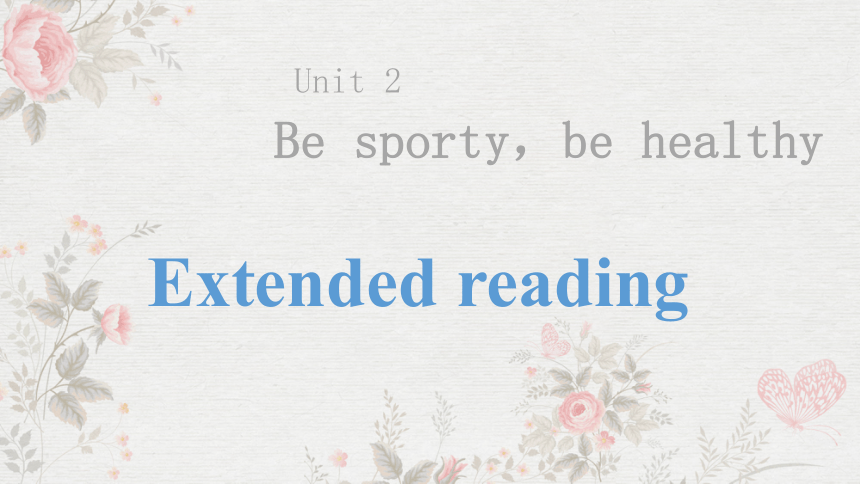 | |
| 格式 | pptx | ||
| 文件大小 | 37.5MB | ||
| 资源类型 | 教案 | ||
| 版本资源 | 牛津译林版(2019) | ||
| 科目 | 英语 | ||
| 更新时间 | 2024-03-27 22:17:21 | ||
图片预览

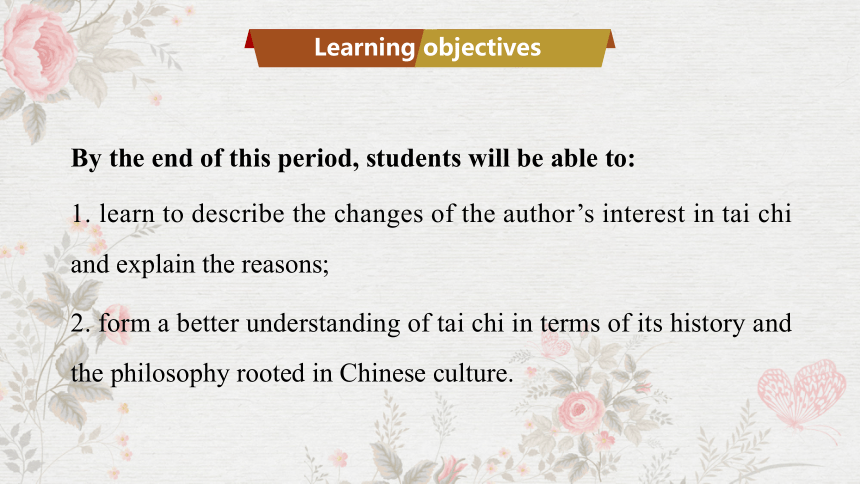
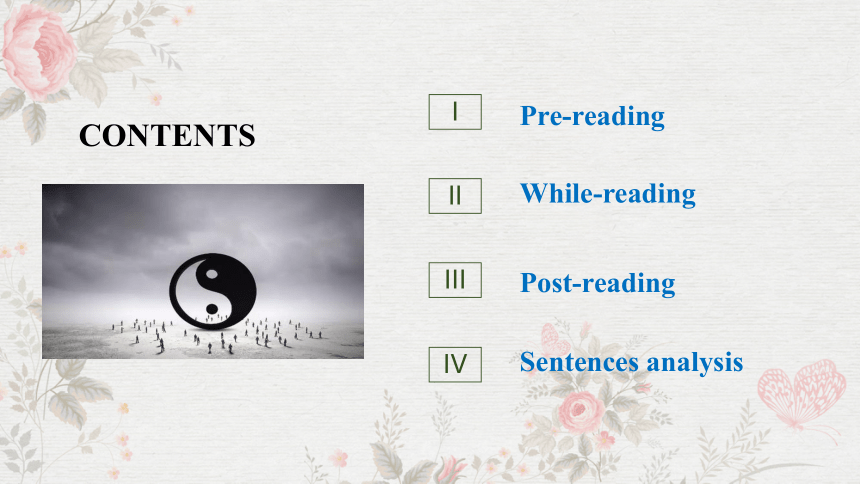
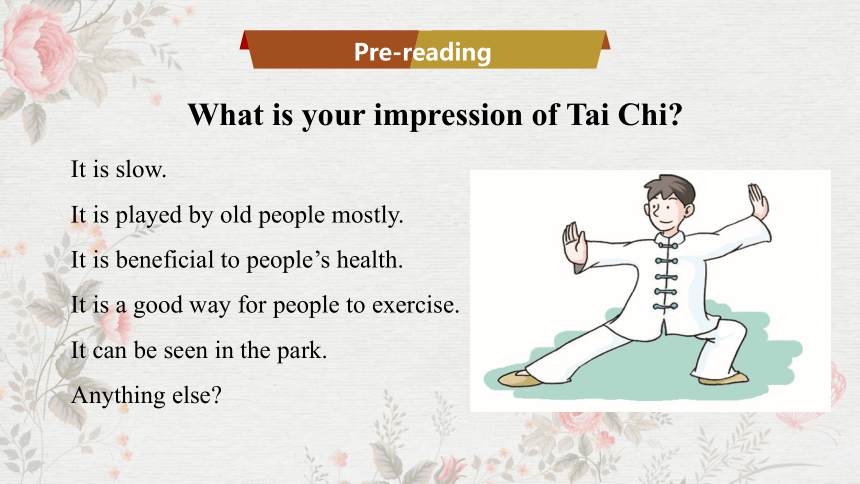
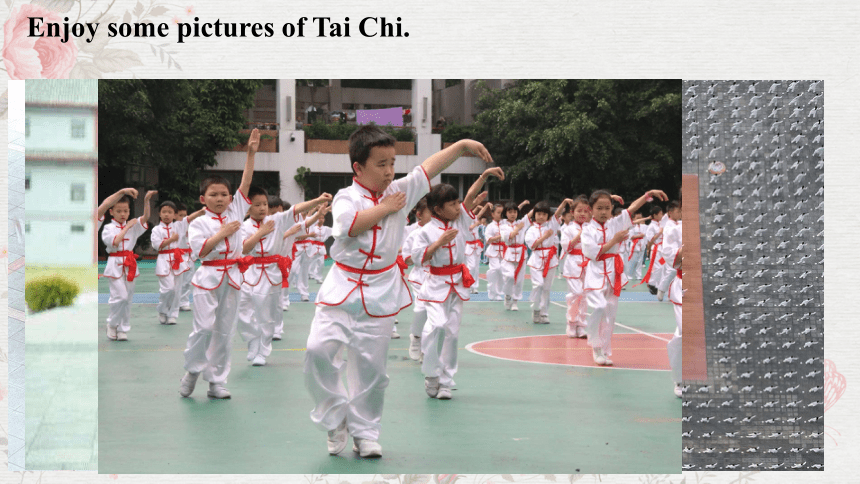
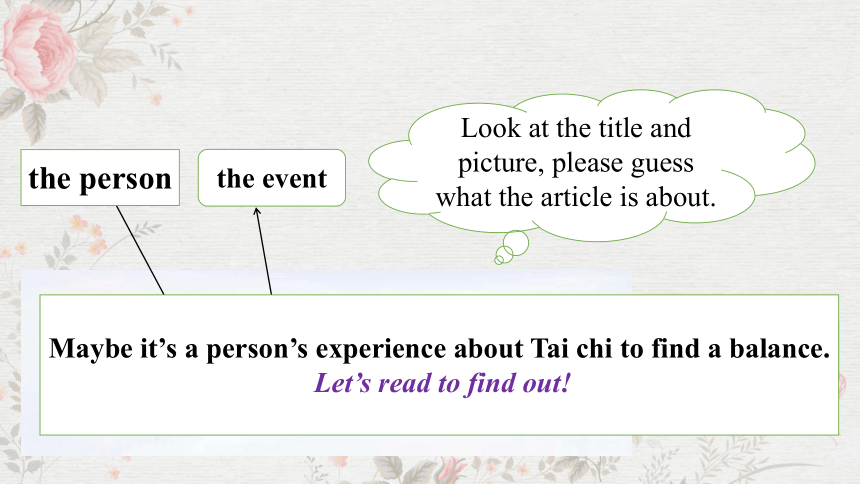
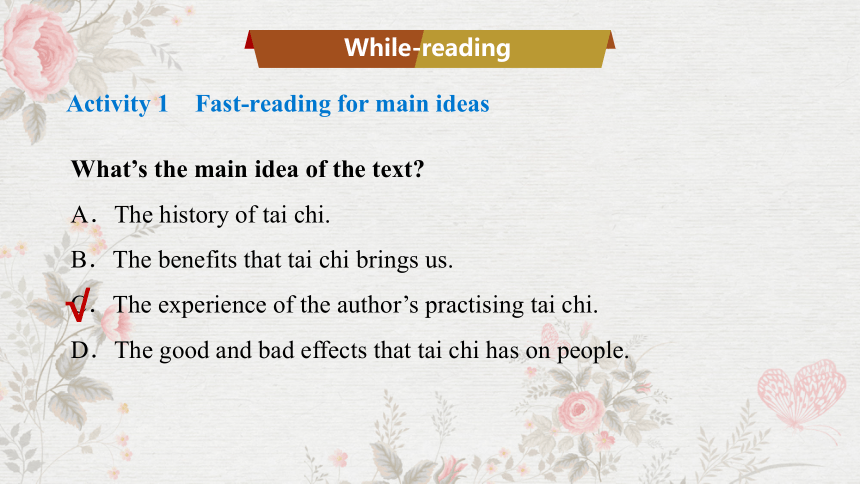
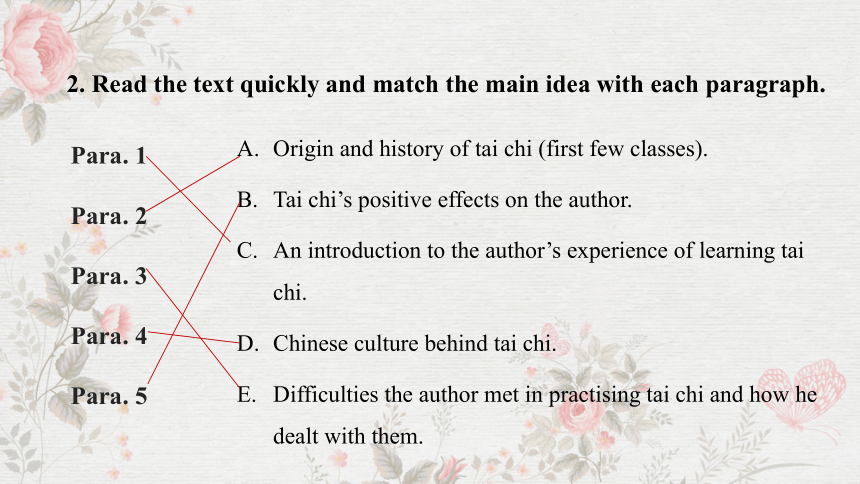
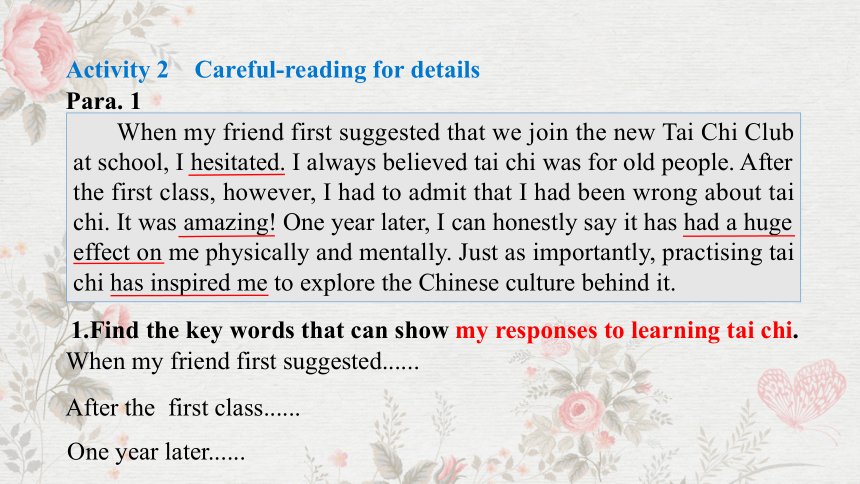
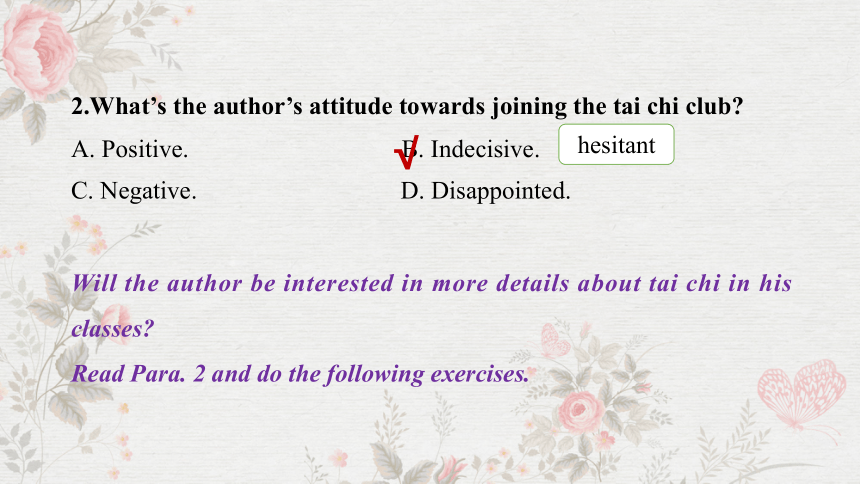
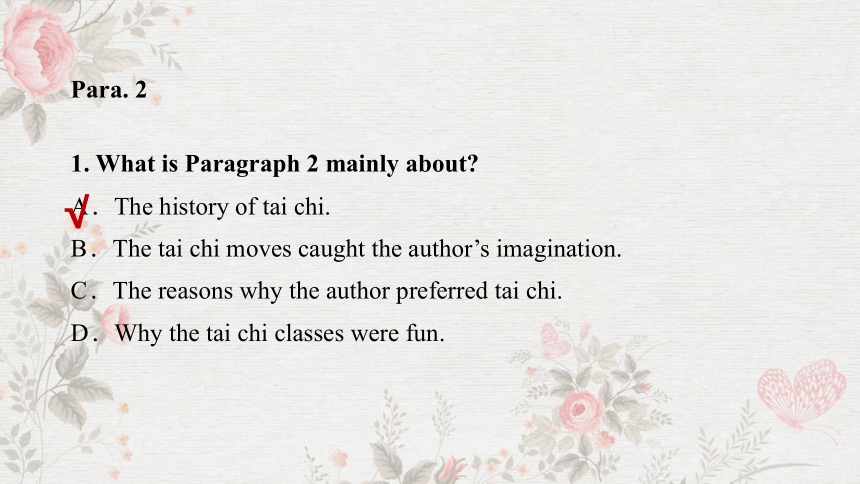
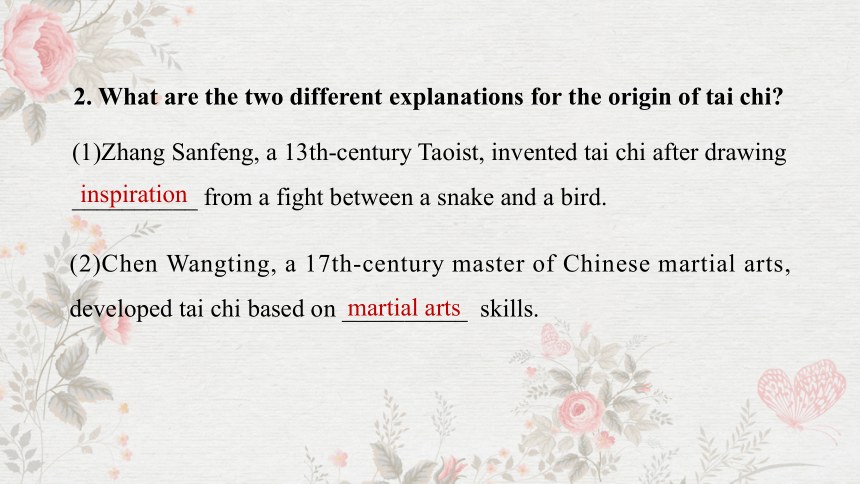
文档简介
(共36张PPT)
Extended reading
Unit 2
Be sporty,be healthy
Learning objectives
By the end of this period, students will be able to:
1. learn to describe the changes of the author’s interest in tai chi and explain the reasons;
2. form a better understanding of tai chi in terms of its history and the philosophy rooted in Chinese culture.
CONTENTS
Pre-reading
I
While-reading
II
Post-reading
III
Sentences analysis
IV
What is your impression of Tai Chi
It is slow.
It is played by old people mostly.
It is beneficial to people’s health.
It is a good way for people to exercise.
It can be seen in the park.
Anything else
Pre-reading
Enjoy some pictures of Tai Chi.
Look at the title and picture, please guess what the article is about.
the person
the event
the purpose
Maybe it’s a person’s experience about Tai chi to find a balance.
Let’s read to find out!
What’s the main idea of the text
A.The history of tai chi.
B.The benefits that tai chi brings us.
C.The experience of the author’s practising tai chi.
D.The good and bad effects that tai chi has on people.
√
While-reading
Activity 1 Fast-reading for main ideas
Para. 1
Para. 2
Para. 3
Para. 4
Para. 5
Origin and history of tai chi (first few classes).
Tai chi’s positive effects on the author.
An introduction to the author’s experience of learning tai chi.
Chinese culture behind tai chi.
Difficulties the author met in practising tai chi and how he dealt with them.
2. Read the text quickly and match the main idea with each paragraph.
When my friend first suggested that we join the new Tai Chi Club at school, I hesitated. I always believed tai chi was for old people. After the first class, however, I had to admit that I had been wrong about tai chi. It was amazing! One year later, I can honestly say it has had a huge effect on me physically and mentally. Just as importantly, practising tai chi has inspired me to explore the Chinese culture behind it.
1.Find the key words that can show my responses to learning tai chi.
When my friend first suggested......
After the first class......
One year later......
Activity 2 Careful-reading for details
Para. 1
2.What’s the author’s attitude towards joining the tai chi club
A. Positive. B. Indecisive.
C. Negative. D. Disappointed.
√
hesitant
Will the author be interested in more details about tai chi in his classes
Read Para. 2 and do the following exercises.
1. What is Paragraph 2 mainly about
A.The history of tai chi.
B.The tai chi moves caught the author’s imagination.
C.The reasons why the author preferred tai chi.
D.Why the tai chi classes were fun.
Para. 2
√
(2)Chen Wangting, a 17th-century master of Chinese martial arts, developed tai chi based on __________ skills.
(1)Zhang Sanfeng, a 13th-century Taoist, invented tai chi after drawing __________ from a fight between a snake and a bird.
inspiration
martial arts
2. What are the two different explanations for the origin of tai chi
3.Which one is NOT the style developed after Chen-style tai chi
A.Yang-style. B.Wu-style.
C.Sun-style. D.Zhang-style.
4.Why are some tai chi moves named after animals
A.Because Zhang Sanfeng liked animals.
B.Because Chen Wangting liked animals.
C.Because masters of Chinese martial arts loved living with animals.
D.Because Chinese martial arts have a long-standing practice of imitating animals.
√
√
White crane spreading its wings
Golden rooter standing on one leg
Wild Horse Parts Mane
Grasping sparrow(麻雀) tail
They have a long-standing practice of imitating animals.
5.Learn and imitate the moves of tai chi in the article.
Show the moves to us!
野马分鬃
白鹤亮翅
金鸡独立
揽雀尾
hard-working ,intelligent ,full of wisdom, imaginative,
6. From these interesting names of tai chi moves what can you learn about ancient Chinese people Express yourself freely.
They were...
creative, observant, enthusiasm and loved life...
What difficulties did the author encounter in practicing Tai Chi and how did he overcome them (after the first few classes)
What was the author’s problem
He found himself_________________ from doing the same moves over and over again.
How did the author solve his problem
His coach taught him how to___________________ and
_______________________ while performing the routine.
How was the author after he solved the problem
1._________________________________________________
2._________________________________________________
3._________________________________________________
bored and aching
relax his muscles
focus on peace of mind
His balance and flexibility slowly improved.
He was able to do more difficult moves.
His love for tai chi returned stronger than ever.
Para. 3
Enjoy the video. Have you fallen in love with Tai Chi
1.Read para 4 carefully and complete the chart.
Essence of tai chi
Chinese philosophy of (1) ______________
the unity of (2) ______________
the practice of tai chi aims to maintain the balance of yin and yang in the body through (3) ________________
(4) ___________________
(5) ___________________
(6) ___________________
breathing in and breathing out
yin and yang
opposites
opposite movements
forwards and backwards
up and down
left and right
Eventually, tai chi brings about a state of _______________ and _____________.
physical balance
mental peace
Para. 4
2. How do you understand “there is no shadow without light” Why is it used here
Where there is light, there is a shadow.
The author uses this example to explain the unity of opposites, which cannot exist without each other.
3. Can you make up more sentences to explain the philosophy of yin and yang
The Chinese culture behind tai chi
There is no ______ without wrong.
There is no fairness without ____________.
There is no _______ without black.
There is no day without ______.
There is no _______ without failure.
right
unfairness
white
night
success
A year of practising tai chi has had a positive effect on my everyday life. I sleep better at night, and I am more energetic during the day. I feel happier and more confident. Tai chi has taught me to relax my mind, enabling me to stay cool in stressful situations . I am sure I will continue to practise tai chi and enjoy the benefits it has brought me.
1. Read carefully and underline the topic sentence of this paragraph.
2. What can we learn from paragraph 5
A.Tai chi has a bad effect on the author.
B.Tai chi has brought a lot of benefits to the author.
C.Tai chi is deeply rooted in the Chinese philosophy.
D.The author is able to do more difficult moves.
√
Para. 5
Time Feelings Reasons
When his friend suggested
After learning the basics of tai chi
happier and more confident
satisfied
bored
amazing
hesitant
After my coach’s guidance
A year of practising tai chi
positive effects & benefits
balance and flexibility improved
doing the same moves over and over again
fun and easy
for old people
The first few tai chi classes
1. Fill in the chart according to the whole passage.
the whole passage
time
interest
time
interest
time
interest
time
interest
A
B
C
D
2.Which best describes the change of the author’s attitude to tai chi
√
3. How does this passage developed
A. By following space order.
B. By following time order.
C. By listing examples.
D. From general to details.
√
4.Which shows the right structure of the article
√
5.What is the writer’s attitude towards practising tai chi in the passage
A.The writer is against it.
B.The writer is in favour of it.
C.The writer does not state any personal opinion about it.
D.The writer shows no interest in it.
√
sleep
energy
confidence
relax
recover
physical balance
inner peace
benefits of tai chi
Just as the article says, the unity of opposites cannot exist independently of each other. Opposites are there to keep balance and if broken, an imbalance may occur, which could cause many problems.
1.How do you understand the unity of opposites (Critical thinking)
Post-reading
Activity 1 Discussion
Answers may vary.
2. Write an application to the Tai Chi Club, and express your hope and your advantages. (Creative thinking)
When my friend first suggested that we 1.____________(join) the new Tai Chi Club, I hesitated. After the first class, however, I had to admit that tai chi was 2._________ (amaze)! I can 3._________ (honest) say it has had a huge effect 4.______ me physically and mentally.5.__________(practise) tai chi has inspired me to explore the Chinese culture behind it.
Zhang Sanfeng was said 6.______________ (invent) tai chi. However, nowadays people tend to believe that Chen Wangting developed tai chi 7.______(base) on martial arts skills. Since Chinese martial arts have a long-standing practice of imitating animals, 8.____ is not surprising that some tai chi moves 9.__________(name) after animals. I will continue to practise tai chi and enjoy the benefits 10.___________ it has brought me.
(should) join
amazing
on
honestly
Practising
to have invented
based
it
are named
that/which
Activity 2 Summary
1. When my friend first suggested that we join the new Tai Chi Club at school, I hesitated. (Para. 1 Line 1)
[句式分析] 此句为________句,主句为:_____;when引导____________,句中suggest 后that引导__________,表示________________,此时从句使用_____语气,即谓语为_______________。
[自主翻译]
主从复合
时间状语从句
建议、命令、要求
一开始,当朋友建议我们加入学校新成立的太极拳俱乐部时,
宾语从句
虚拟
(should+)动词原形
Sentences analysis
我犹豫了。
After the first class, however, I had to admit that I had been wrong about tai chi. (Para. 1 Line 2)
[句式分析] 此句为__________句;however为_______,可修饰句子;主句主语和谓语为_________;that引导______________。
[自主翻译]
主从复合
副词
宾语从句
不过,上完第一堂课后,我不得不承认,我之前对太极拳的认识是错误的。
3.When I asked my coach where these interesting names came from,
he told me about the history of tai chi. (Para. 2 Line 9)
[句式分析] 此句为__________句;句子主干为:_____,when引导______________,从句中where引导__________。
[自主翻译]
主从复合
时间状语从句
宾语从句
当我问教练这些有趣的名字从何而来时,他向我道出了太极拳的历史。
4. With these requirements of tai chi in mind, I found to my satisfaction that my balance and flexibility slowly improved, that I was able to do more difficult moves, and that my love for tai chi returned stronger than ever. (Para. 3 Line 23)
[句式分析] 此句为_________句;With these ...为介词的复合结构作______;to my satisfaction意为“____________”,主句的主语和谓语为____,found后为三个that引导的并列的__________。
[自主翻译]
令我欣慰的是
状语
主从复合
宾语从句
将太极拳的这些要求铭记于心,慢慢地,我发现自己的平衡能力和柔韧性得到了改善,我能完成难度更大的动作,我对太极拳的热爱又回来了,而且比以前更强烈,这令我十分满意。
5. I discovered that tai chi is deeply rooted in the Chinese philosophy of yin and yang, which are believed to form the unity of opposites. (Para. 4 Line 2)
[句式分析] 此句为________句,主句主语和谓语为______,that引导___________,be rooted in意为“_______________________”;which引导___________________。
[自主翻译]
主从复合
宾语从句
非限制性定语从句
根源在于,由……产生
我发现,太极拳深深地扎根于中国的阴阳学说之中,人们认为阴和阳构成了对立统一。
6. Tai chi has taught me to relax my mind, enabling me to stay cool in stressful situations. (Para. 5 Line 39)
[句式分析] 此句为_____句;enabling me to stay cool......为现在分词短语作__________,此句主语为_________,与enable之间为_______关系,故用现在分词。
[自主翻译]
结果状语
Tai Chi
主动
太极拳让我学会了放松心态,使我在有压力的环境下也能冷静应对。
简单
Homework
Review what we have learnt and preview language points.
Extended reading
Unit 2
Be sporty,be healthy
Learning objectives
By the end of this period, students will be able to:
1. learn to describe the changes of the author’s interest in tai chi and explain the reasons;
2. form a better understanding of tai chi in terms of its history and the philosophy rooted in Chinese culture.
CONTENTS
Pre-reading
I
While-reading
II
Post-reading
III
Sentences analysis
IV
What is your impression of Tai Chi
It is slow.
It is played by old people mostly.
It is beneficial to people’s health.
It is a good way for people to exercise.
It can be seen in the park.
Anything else
Pre-reading
Enjoy some pictures of Tai Chi.
Look at the title and picture, please guess what the article is about.
the person
the event
the purpose
Maybe it’s a person’s experience about Tai chi to find a balance.
Let’s read to find out!
What’s the main idea of the text
A.The history of tai chi.
B.The benefits that tai chi brings us.
C.The experience of the author’s practising tai chi.
D.The good and bad effects that tai chi has on people.
√
While-reading
Activity 1 Fast-reading for main ideas
Para. 1
Para. 2
Para. 3
Para. 4
Para. 5
Origin and history of tai chi (first few classes).
Tai chi’s positive effects on the author.
An introduction to the author’s experience of learning tai chi.
Chinese culture behind tai chi.
Difficulties the author met in practising tai chi and how he dealt with them.
2. Read the text quickly and match the main idea with each paragraph.
When my friend first suggested that we join the new Tai Chi Club at school, I hesitated. I always believed tai chi was for old people. After the first class, however, I had to admit that I had been wrong about tai chi. It was amazing! One year later, I can honestly say it has had a huge effect on me physically and mentally. Just as importantly, practising tai chi has inspired me to explore the Chinese culture behind it.
1.Find the key words that can show my responses to learning tai chi.
When my friend first suggested......
After the first class......
One year later......
Activity 2 Careful-reading for details
Para. 1
2.What’s the author’s attitude towards joining the tai chi club
A. Positive. B. Indecisive.
C. Negative. D. Disappointed.
√
hesitant
Will the author be interested in more details about tai chi in his classes
Read Para. 2 and do the following exercises.
1. What is Paragraph 2 mainly about
A.The history of tai chi.
B.The tai chi moves caught the author’s imagination.
C.The reasons why the author preferred tai chi.
D.Why the tai chi classes were fun.
Para. 2
√
(2)Chen Wangting, a 17th-century master of Chinese martial arts, developed tai chi based on __________ skills.
(1)Zhang Sanfeng, a 13th-century Taoist, invented tai chi after drawing __________ from a fight between a snake and a bird.
inspiration
martial arts
2. What are the two different explanations for the origin of tai chi
3.Which one is NOT the style developed after Chen-style tai chi
A.Yang-style. B.Wu-style.
C.Sun-style. D.Zhang-style.
4.Why are some tai chi moves named after animals
A.Because Zhang Sanfeng liked animals.
B.Because Chen Wangting liked animals.
C.Because masters of Chinese martial arts loved living with animals.
D.Because Chinese martial arts have a long-standing practice of imitating animals.
√
√
White crane spreading its wings
Golden rooter standing on one leg
Wild Horse Parts Mane
Grasping sparrow(麻雀) tail
They have a long-standing practice of imitating animals.
5.Learn and imitate the moves of tai chi in the article.
Show the moves to us!
野马分鬃
白鹤亮翅
金鸡独立
揽雀尾
hard-working ,intelligent ,full of wisdom, imaginative,
6. From these interesting names of tai chi moves what can you learn about ancient Chinese people Express yourself freely.
They were...
creative, observant, enthusiasm and loved life...
What difficulties did the author encounter in practicing Tai Chi and how did he overcome them (after the first few classes)
What was the author’s problem
He found himself_________________ from doing the same moves over and over again.
How did the author solve his problem
His coach taught him how to___________________ and
_______________________ while performing the routine.
How was the author after he solved the problem
1._________________________________________________
2._________________________________________________
3._________________________________________________
bored and aching
relax his muscles
focus on peace of mind
His balance and flexibility slowly improved.
He was able to do more difficult moves.
His love for tai chi returned stronger than ever.
Para. 3
Enjoy the video. Have you fallen in love with Tai Chi
1.Read para 4 carefully and complete the chart.
Essence of tai chi
Chinese philosophy of (1) ______________
the unity of (2) ______________
the practice of tai chi aims to maintain the balance of yin and yang in the body through (3) ________________
(4) ___________________
(5) ___________________
(6) ___________________
breathing in and breathing out
yin and yang
opposites
opposite movements
forwards and backwards
up and down
left and right
Eventually, tai chi brings about a state of _______________ and _____________.
physical balance
mental peace
Para. 4
2. How do you understand “there is no shadow without light” Why is it used here
Where there is light, there is a shadow.
The author uses this example to explain the unity of opposites, which cannot exist without each other.
3. Can you make up more sentences to explain the philosophy of yin and yang
The Chinese culture behind tai chi
There is no ______ without wrong.
There is no fairness without ____________.
There is no _______ without black.
There is no day without ______.
There is no _______ without failure.
right
unfairness
white
night
success
A year of practising tai chi has had a positive effect on my everyday life. I sleep better at night, and I am more energetic during the day. I feel happier and more confident. Tai chi has taught me to relax my mind, enabling me to stay cool in stressful situations . I am sure I will continue to practise tai chi and enjoy the benefits it has brought me.
1. Read carefully and underline the topic sentence of this paragraph.
2. What can we learn from paragraph 5
A.Tai chi has a bad effect on the author.
B.Tai chi has brought a lot of benefits to the author.
C.Tai chi is deeply rooted in the Chinese philosophy.
D.The author is able to do more difficult moves.
√
Para. 5
Time Feelings Reasons
When his friend suggested
After learning the basics of tai chi
happier and more confident
satisfied
bored
amazing
hesitant
After my coach’s guidance
A year of practising tai chi
positive effects & benefits
balance and flexibility improved
doing the same moves over and over again
fun and easy
for old people
The first few tai chi classes
1. Fill in the chart according to the whole passage.
the whole passage
time
interest
time
interest
time
interest
time
interest
A
B
C
D
2.Which best describes the change of the author’s attitude to tai chi
√
3. How does this passage developed
A. By following space order.
B. By following time order.
C. By listing examples.
D. From general to details.
√
4.Which shows the right structure of the article
√
5.What is the writer’s attitude towards practising tai chi in the passage
A.The writer is against it.
B.The writer is in favour of it.
C.The writer does not state any personal opinion about it.
D.The writer shows no interest in it.
√
sleep
energy
confidence
relax
recover
physical balance
inner peace
benefits of tai chi
Just as the article says, the unity of opposites cannot exist independently of each other. Opposites are there to keep balance and if broken, an imbalance may occur, which could cause many problems.
1.How do you understand the unity of opposites (Critical thinking)
Post-reading
Activity 1 Discussion
Answers may vary.
2. Write an application to the Tai Chi Club, and express your hope and your advantages. (Creative thinking)
When my friend first suggested that we 1.____________(join) the new Tai Chi Club, I hesitated. After the first class, however, I had to admit that tai chi was 2._________ (amaze)! I can 3._________ (honest) say it has had a huge effect 4.______ me physically and mentally.5.__________(practise) tai chi has inspired me to explore the Chinese culture behind it.
Zhang Sanfeng was said 6.______________ (invent) tai chi. However, nowadays people tend to believe that Chen Wangting developed tai chi 7.______(base) on martial arts skills. Since Chinese martial arts have a long-standing practice of imitating animals, 8.____ is not surprising that some tai chi moves 9.__________(name) after animals. I will continue to practise tai chi and enjoy the benefits 10.___________ it has brought me.
(should) join
amazing
on
honestly
Practising
to have invented
based
it
are named
that/which
Activity 2 Summary
1. When my friend first suggested that we join the new Tai Chi Club at school, I hesitated. (Para. 1 Line 1)
[句式分析] 此句为________句,主句为:_____;when引导____________,句中suggest 后that引导__________,表示________________,此时从句使用_____语气,即谓语为_______________。
[自主翻译]
主从复合
时间状语从句
建议、命令、要求
一开始,当朋友建议我们加入学校新成立的太极拳俱乐部时,
宾语从句
虚拟
(should+)动词原形
Sentences analysis
我犹豫了。
After the first class, however, I had to admit that I had been wrong about tai chi. (Para. 1 Line 2)
[句式分析] 此句为__________句;however为_______,可修饰句子;主句主语和谓语为_________;that引导______________。
[自主翻译]
主从复合
副词
宾语从句
不过,上完第一堂课后,我不得不承认,我之前对太极拳的认识是错误的。
3.When I asked my coach where these interesting names came from,
he told me about the history of tai chi. (Para. 2 Line 9)
[句式分析] 此句为__________句;句子主干为:_____,when引导______________,从句中where引导__________。
[自主翻译]
主从复合
时间状语从句
宾语从句
当我问教练这些有趣的名字从何而来时,他向我道出了太极拳的历史。
4. With these requirements of tai chi in mind, I found to my satisfaction that my balance and flexibility slowly improved, that I was able to do more difficult moves, and that my love for tai chi returned stronger than ever. (Para. 3 Line 23)
[句式分析] 此句为_________句;With these ...为介词的复合结构作______;to my satisfaction意为“____________”,主句的主语和谓语为____,found后为三个that引导的并列的__________。
[自主翻译]
令我欣慰的是
状语
主从复合
宾语从句
将太极拳的这些要求铭记于心,慢慢地,我发现自己的平衡能力和柔韧性得到了改善,我能完成难度更大的动作,我对太极拳的热爱又回来了,而且比以前更强烈,这令我十分满意。
5. I discovered that tai chi is deeply rooted in the Chinese philosophy of yin and yang, which are believed to form the unity of opposites. (Para. 4 Line 2)
[句式分析] 此句为________句,主句主语和谓语为______,that引导___________,be rooted in意为“_______________________”;which引导___________________。
[自主翻译]
主从复合
宾语从句
非限制性定语从句
根源在于,由……产生
我发现,太极拳深深地扎根于中国的阴阳学说之中,人们认为阴和阳构成了对立统一。
6. Tai chi has taught me to relax my mind, enabling me to stay cool in stressful situations. (Para. 5 Line 39)
[句式分析] 此句为_____句;enabling me to stay cool......为现在分词短语作__________,此句主语为_________,与enable之间为_______关系,故用现在分词。
[自主翻译]
结果状语
Tai Chi
主动
太极拳让我学会了放松心态,使我在有压力的环境下也能冷静应对。
简单
Homework
Review what we have learnt and preview language points.
